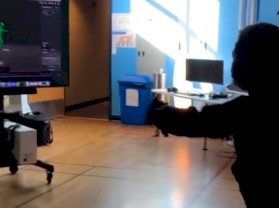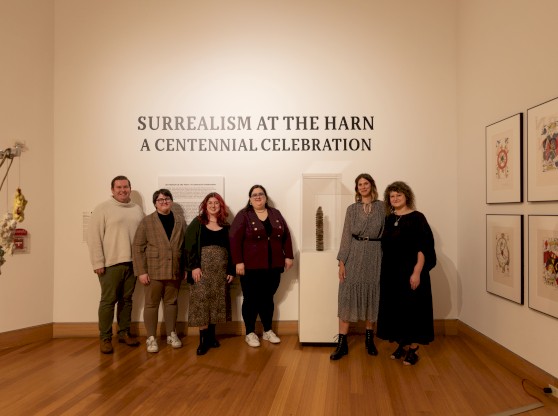When Tzveta Kassabova approached Dr. Elif Akcali about a collaboration in 2012, Akcali was unsure how to respond. Akcali was an Industrial Systems Engineer; Kassabova was a dancer and choreographer. On the surface, a collaboration seemed nearly impossible, but Akcali’s interest was piqued and she agreed to meet up to discuss the possibility of working together in the future.
So they got coffee. To onlookers, they likely seemed an odd pair. “I showed up in my black boring business attire and she came in wearing her colorful studio clothes,” Akcali recalled. “I ordered a double-shot espresso and she had her healthy green tea.”
The meeting got off to an uncomfortable start when Akcali asked what Kassabova’s project was about. Kassabova did not have a clear vision for her project yet; she just knew she wanted to collaborate with people like Akcali, people who worked in different fields and could bring new perspectives to her art.
Akcali was determined to keep an open mind and the two agreed to meet once a week. Akcali started dropping by Kassabova’s classes and rehearsals developing an appreciation for an artform that she had previously never considered. Eventually, Akcali worked on a proposal to become one of the first UF faculty members to become a “creative Scholar-in-Residence,” which allowed her to dedicate 50% of her time to the School of Theatre and Dance. While there, Akcali would crystallize their collaboration with tangible experiments: One designed to teach a process engineering tool to edit dance works, and another to teach storytelling and choreography skills to engineer students to more fluidly explain their senior project.
Akcali described her time at SoTD in many ways – challenging, scary, exciting and, most of all, transformative.
It changed the way she taught, too. Suddenly her “impeccably planned” classes started to spiral out of control. She would ask her engineering students to draw a cartoon or write a poem to explain a problem. At first, they were lost and uncomfortable, unsure how to respond to such vague directions in a usually structured environment. Engineers like to be in full control, but Akcali had learned that it was the feeling of not having full control that allowed her to grow as an educator and researcher.
“You can’t play it safe in collaborations,” Akcali explained. “It’s important to be challenged by your collaborations, to let go of your intellectual ego, and to trust the process.”
This was one of the principal messages of a recent “Collision Event” put on by the College of the Arts, aimed to bring UF educators from all fields together to begin discussing possible collaborations. Over forty professors, intellectuals and artists gathered at the Phillips Center to watch a performance by tap dancer and choreographer Michelle Dorrance and her troupe Dorrance Dance, whose work embodies the ideals of this cross-field collaboration.
Along with her longtime friend Nicholas Van Young, Dorrance brings art and technology together in a complicated process that looks effortless to the untrained eye. Dorrance and the dancers work on electronic “triggerboards” made of low-cost materials that are designed to make different sounds as the dancers move. Every movement triggers a different sound, and the dancers are tasked with making a show that is both visually and audibly stimulating. While the show does have some choreographed numbers, the dancers also have the freedom to create new pieces, so that no two shows are ever exactly the same.
“It’s a lot of improv, a lot of thinking on the spot and reading the energy of the room and of each other,” Dorrance explained.
Dorrance was a MacArthur Genius Grant recipient in 2015, and her goal is to elevate the medium of tap dancing in circles where it has been previously ignored. She also explained her hope to work with STEM and STEAM (Science, Technology, Engineering, Art and Mathematics) education programs to demonstrate how this fusion of art and technology can be both feasible and exciting.
This Collision event is the first of many in the works put on by the Arts, Humanities, and Cultural Institutions Master Plan Steering Committee. The College of the Arts, in tandem with representatives from UF’s libraries, the Harn, the Florida Museum of Natural History, and the College of Liberal Arts and Sciences, have organized a monthly meeting to discuss a five-year master plan that is designed to make the arts more centralized at the University of Florida.
By bringing UF faculty members from diverse fields together, they are taking the first step in that direction. At the event, guests were invited and encouraged to mingle and discuss the possibility of future collaborations. Brian Jose, the Director of University of Florida Performing Arts, had the idea to incorporate a small performance by Dorrance Dance into the event. Having previously seen Dorrance and her troupe perform, Jose knew it would be a perfect complement to a night that was dedicated to cross-field collaboration.
According to Anthony Kolenic, Assistant Dean of the College of the Arts, “We want to integrate and change what art means here at UF, and we can do that through collaboration.”
Centralizing the arts and growing their presence at a STEM-led University is hardly a small task, but with the support of the Office of the Provost and the dedication of the College of the Arts' Dean Lavelli, the next five years will represent a huge turning point for the College of the Arts, and likely for the University of Florida as a whole.



